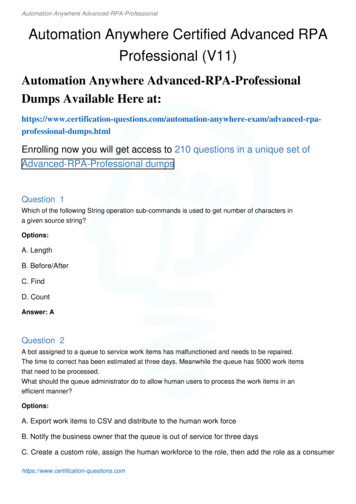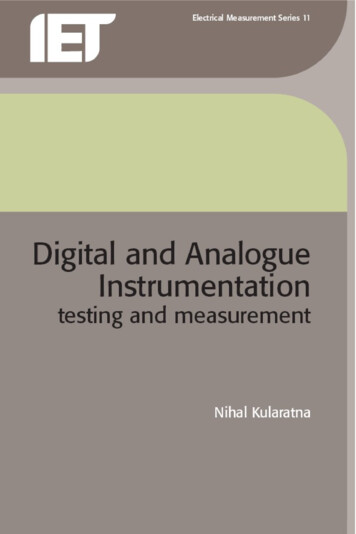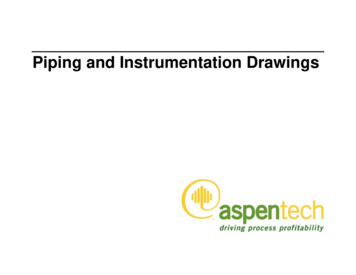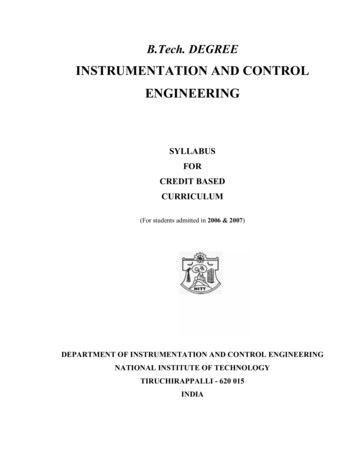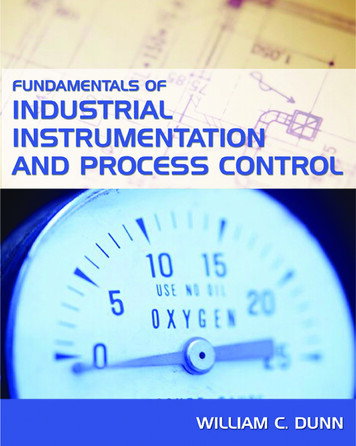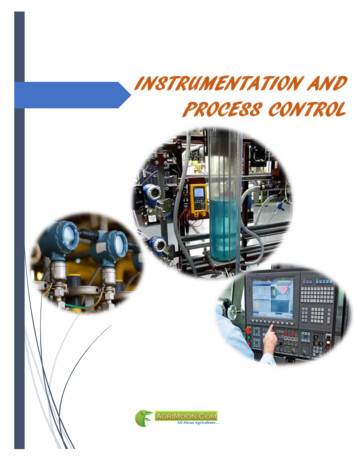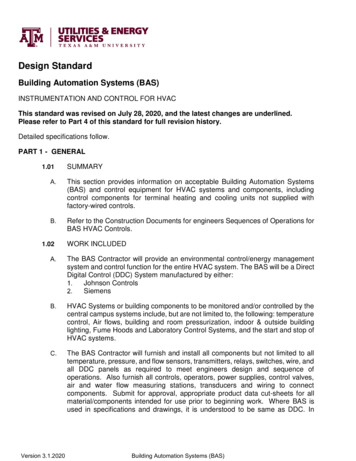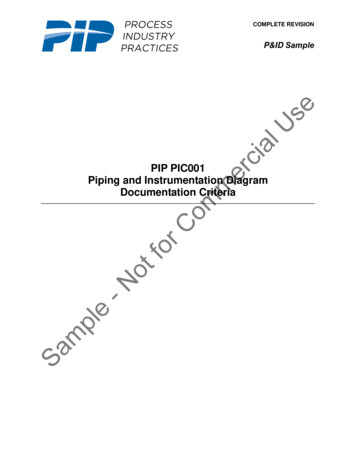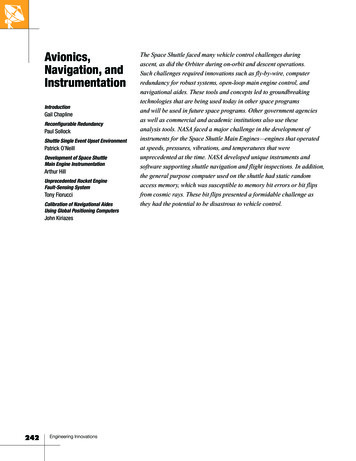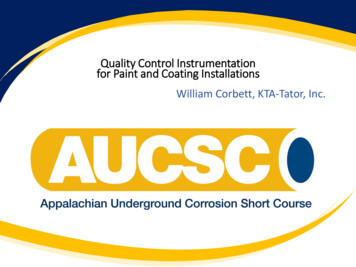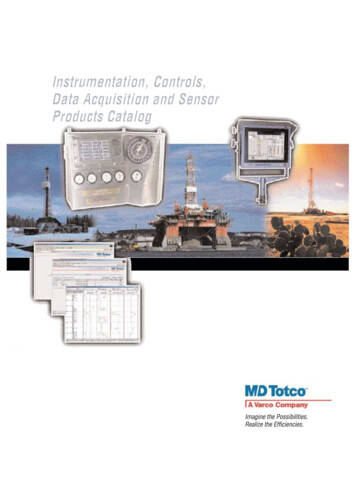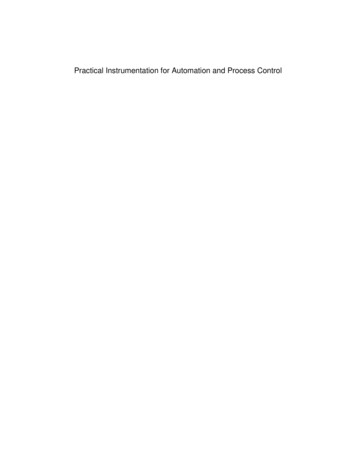
Transcription
Practical Instrumentation for Automation and Process Control
THIS BOOK WAS DEVELOPED BY IDC TECHNOLOGIESWHO ARE WE?IDC Technologies is internationally acknowledged as the premier provider of practical, technical trainingfor engineers and technicians.We specialize in the fields of electrical systems, industrial data communications, telecommunications,automation and control, mechanical engineering, chemical and civil engineering, and are continuallyadding to our portfolio of over 60 different workshops. Our instructors are highly respected in their fieldsof expertise and in the last ten years have trained over 200,000 engineers, scientists and technicians.With offices conveniently located worldwide, IDC Technologies has an enthusiastic team of professionalengineers, technicians and support staff who are committed to providing the highest level of training andconsultancy.TECHNICAL WORKSHOPSTRAINING THAT WORKSWe deliver engineering and technology training that will maximize your business goals. In today’scompetitive environment, you require training that will help you and your organization to achieve its goalsand produce a large return on investment. With our ‘training that works’ objective you and yourorganization will: Get job-related skills that you need to achieve your business goals Improve the operation and design of your equipment and plant Improve your troubleshooting abilities Sharpen your competitive edge Boost morale and retain valuable staff Save time and moneyEXPERT INSTRUCTORSWe search the world for good quality instructors who have three outstanding attributes:1. Expert knowledge and experience – of the course topic2. Superb training abilities – to ensure the know-how is transferred effectively and quickly to you ina practical, hands-on way3. Listening skills – they listen carefully to the needs of the participants and want to ensure that youbenefit from the experience.Each and every instructor is evaluated by the delegates and we assess the presentation after every class toensure that the instructor stays on track in presenting outstanding courses.HANDS-ON APPROACH TO TRAININGAll IDC Technologies workshops include practical, hands-on sessions where the delegates are given theopportunity to apply in practice the theory they have learnt.REFERENCE MATERIALSA fully illustrated workshop book with hundreds of pages of tables, charts, figures and handy hints, plusconsiderable reference material is provided FREE of charge to each delegate.ACCREDITATION AND CONTINUING EDUCATIONSatisfactory completion of all IDC workshops satisfies the requirements of the International Associationfor Continuing Education and Training for the award of 1.4 Continuing Education Units.IDC workshops also satisfy criteria for Continuing Professional Development according to therequirements of the Institution of Electrical Engineers and Institution of Measurement and Control in theUK, Institution of Engineers in Australia, Institution of Engineers New Zealand, and others.
CERTIFICATE OF ATTENDANCEEach delegate receives a Certificate of Attendance documenting their experience.100% MONEY BACK GUARANTEEIDC Technologies’ engineers have put considerable time and experience into ensuring that you gainmaximum value from each workshop. If by lunchtime on the first day you decide that the workshop is notappropriate for your requirements, please let us know so that we can arrange a 100% refund of your fee.ONSITE WORKSHOPSAll IDC Technologies Training Workshops are available on an on-site basis, presented at the venue ofyour choice, saving delegates travel time and expenses, thus providing your company with even greatersavings.OFFICE LOCATIONSAUSTRALIA CANADA INDIA IRELAND MALAYSIA NEW ZEALAND POLAND SINGAPORE SOUTH AFRICA UNITED KINGDOM UNITED STATESidc@idc-online.comwww.idc-online.comVisit our website for FREE Pocket GuidesIDC Technologies produce a set of 6 Pocket Guides used bythousands of engineers and technicians worldwide.Vol. 1 – ELECTRONICSVol. 4 – INSTRUMENTATIONVol. 2 – ELECTRICALVol. 5 – FORMULAE & CONVERSIONSVol. 3 – COMMUNICATIONS Vol. 6 – INDUSTRIAL AUTOMATIONTo download a FREE copy of these internationally best selling pocket guides go to:www.idc-online.com/downloads/
PresentsPracticalInstrumentation for Automation andProcess ControlRevision 7Website: www.idc-online.comE-mail: idc@idc-online.com
IDC Technologies Pty LtdPO Box 1093, West Perth, Western Australia 6872Offices in Australia, New Zealand, Singapore, United Kingdom, Ireland, Malaysia, Poland, United States ofAmerica, Canada, South Africa and IndiaCopyright IDC Technologies 2011. All rights reserved.First published 2008All rights to this publication, associated software and workshop are reserved. No part of this publicationmay be reproduced, stored in a retrieval system or transmitted in any form or by any means electronic,mechanical, photocopying, recording or otherwise without the prior written permission of the publisher. Allenquiries should be made to the publisher at the address above.DisclaimerWhilst all reasonable care has been taken to ensure that the descriptions, opinions, programs, listings,software and diagrams are accurate and workable, IDC Technologies do not accept any legal responsibilityor liability to any person, organization or other entity for any direct loss, consequential loss or damage,however caused, that may be suffered as a result of the use of this publication or the associated workshopand software.In case of any uncertainty, we recommend that you contact IDC Technologies for clarification or assistance.TrademarksAll logos and trademarks belong to, and are copyrighted to, their companies respectively.AcknowledgementsIDC Technologies expresses its sincere thanks to all those engineers and technicians on our trainingworkshops who freely made available their expertise in preparing this manual.
61.71.823368142526Pressure 55Principles of pressure managementPressure sourcesPressure transducers and elements – mechanicalPressure transducers and elements – electricalInstallation considerationsImpact on the overall control loopSelection tablesFuture technologiesLevel 3.133.144Basic measurements and control conceptsBasic measurement performance terms and specificationsAdvanced measurement performance terms andspecificationsDefinition of terminologyProcess and Instrumentation Diagram symbolsEffects of selection criteriaMeasuring instruments and control valves as part of theoverall control systemTypical applicationsPrinciples of level measurementSimple sight glasses and gauging rodsBuoyancy typeHydrostatic pressureUltrasonic measurementRadar measurementVibration switchesRadiation measurementElectrical measurementDensity measurementInstallation considerationsImpact on the overall control loopSelection tablesFuture ture ples of temperature measurementThermocouplesResistance Temperature DetectorsThermistorsLiquid-in-glass, filled, bimetallic
4.64.74.84.94.104.115678Non contact pyrometersHumidityInstallation considerationsImpact on the overall control loopSelection tablesFuture technologies137140142143144147Flow ciples of flow measurementDifferential pressure flowmetersOpen channel flow measurementVariable area flowmetersOscillatory flow measurementMagnetic flowmetersPositive displacementUltrasonic flow measurementMass flow metersInstallation considerationsImpact on overall control loopSelection tablesFuture technologiesControl 228233236242245249250251252Principles of control valvesSliding stem valvesRotary valvesControl valve selection and sizingControl valve characteristics/trimControl valve noise and cavitationActuators and positioners operationValve benchset and strokingImpact on the overall control loopSelection tablesFuture technologiesOther Process Considerations2557.17.27.37.4255261271272The new smart instrument and field busNoise and earthing considerationsMaterials of constructionLinearisationIntegration of the System8.18.28.3275Calculation of individual instruments and total error for thesystem275Selection considerations278Testing and commissioning of the subsystems281
ghtometersCalibrating and testing weightometersOperator checksOther types of weightometers and weighing systemsElectrical disturbances for weighing systems285292297301302312Appendix AThermocouple Tables315Appendix BProcess Instrumentation Practical Exercises401Appendix CUltrasonic Level Measurement423Appendix DMultiple Choice Questions461Appendix EPractical Exercises for Equipment Kit A467Appendix FPractical Exercises for Equipment Kit B511Appendix GInstruction Sheet: Connecting to Remote Labs withinElectromeet537Appendix HRemote Labs Instrumentation Practical: Span and ZeroConfiguration using an Ultrasonic Level Detector 541Appendix IRemote Labs Instrumentation Practical: TemperatureMeasurement Influences Using a Datalogger549
PrefaceThis workshop and accompanying manual is intended for engineers and technicians whoneed to have a practical knowledge for selecting and implementing industrialinstrumentation systems and control valves. It can be argued that a clear understandingand application of the instrumentation and control valves systems is the most importantfactor in an efficient and successful control system.The objectives of the workshop and manual are for you to be able to: Specify and design instrumentation systems.Correctly select and size control valves for industrial use.Understand the problems with installing measurement equipment.Troubleshoot instrumentation systems and control valves.Isolate and rectify instrumentation faults.Understand most of the major technologies used for instrumentation andcontrol valves.The chapters are broken down as follows:Chapter 1 IntroductionThis gives an overview of basic measurement terms and concepts. A review is given ofprocess and instrumentation diagram symbols and places instrumentation and valves inthe context of a complete control system.Chapter 2 Pressure MeasurementThis section commences with a review of the basic terms of pressure measurement andmoves onto pressure sources. The various pressure transducers and elements arediscussed with reference to installation considerations.Chapter 3 Level Measurement
xii Practical Instrumentation for Automation and Process ControlThe principles of level measurement are reviewed and the various techniques examinedranging from simple sight glasses to density measurement. Installation considerations areagain discussed.Chapter 4 Temperature MeasurementThe principles of temperature measurement are discussed and the various transducersexamined ranging from thermocouples to non-contact pyrometers. Installation and impacton the overall loop are also briefly discussed.Chapter 5 Flow MeasurementInitially the basic principles of flow measurement are discussed and then each techniqueis examined. This ranges from differential pressure flowmeters to mass flow meters. Theinstallation aspects are also reviewed.Chapter 6 Control ValvesThe principles of control valves are initially reviewed. Various types of valves rangingfrom sliding stem valves to rotary valves are also discussed. Control valve selection andsizing, characteristics and trim are also examined. The important issues of cavitation andnoise are reviewed. Installation considerations are noted.Chapter 7 Other Process ConsiderationsThe new technologies of smart instruments and FieldBus are discussed. The importantissues of noise and interference are then examined.Chapter 8 Integration of the SystemIssues such as calculation of individual instruments error and total error are reviewed. Afinal summary of the selection considerations for instrumentation systems is discussed.The chapter is completed with a summary of testing and commissioning issues.Chapter 9 WeightometersWeighing systems are used in both static and dynamic applications. Some systems aretechnologically advanced, interfacing with computers for database integration and usingmicro-processor based techniques to proportion material inputs and feed rates.A set of Appendices is included to support the material contained in the manual. Theseinclude:Appendix AAppendix BAppendix CAppendix DAppendix EThermocouple TablesProcess Instrumentation – Practical ExercisesExtracts from Supplier Specifications- Ultrasonic LevelMeasurementMutiple choice - Questions and AnswersPractical Exercises for Equipment Kit A
Preface xiiiAppendix FAppendix GAppendix HAppendix IPractical Exercises for Equipment Kit BInstruction Sheet – Connection to Remote Labs withinElectromeetRemote Labs Instrumentation Practical: Span and ZeroConfiguration using an Ultrasonic Level DetectorRemote Labs Instrumentation Practical: TemperatureMeasurement Influences Using a Datalogger
xiv Practical Instrumentation for Automation and Process Control
1IntroductionIn a time of constant and rapid technological development, it would be quite ambitious todevelop and present a course that claimed to cover each and every industrial measuringtype of equipment. This course is not intended to be an encyclopedia of instrumentationand control valves, but rather a training guide for gaining experience in this fastchanging environment.This course is aimed at providing engineers, technicians and any other personnelinvolved with process measurement, more experience in that field. It is also designed togive students the fundamentals on analysing the process requirements and selectingsuitable solutions for their applications.1.1Basic measurement
instrumentation systems and control valves. It can be argued that a clear understanding and application of the instrumentation and control valves systems is the most important factor in an efficient and successful control system. The objectives of the workshop and manual are for you to be able to: Specify and design instrumentation systems.
